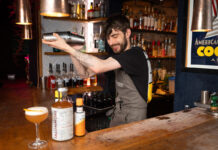There’s no let up in gin growth meaning a good range is a must in bars

THE old precept “if you can’t beat them, join them” seems to be particularly true when it comes to gin.
As more and more operators begin stocking broader ranges of the spirit, the snowballing category is nigh on impossible to ignore, for both licensees and consumers.
And according to gin experts, the category will continue to grow as quality and innovation persistently enlarge the fan base of the distillate, meaning it’s never been more important to have a respectable selection in pubs and bars.
“The growth of the gin category is continuing to surpass all expectations,” said Joanne Motion, UK customer marketing manager at Ian Macleod Distillers, producer of the Edinburgh Gin range.
“According to the 2017 Mintel Forecast, the total gin market in the UK will be worth £1.8 billion by 2021.
“A huge part of the category’s growth is due to the on-trade, as operators provide consumers with a range of premium drinks that appeal to their desire for a quality brand and to meet the consumer trend for exploration within spirits.”
A large part of the explosion in the category has been down to its popularity with younger consumers, stated Carlo Valente, director at VC2 brands, whose portfolio includes Boë Superior Gin.
He said: “Gin had previously suffered from being stuck in the past, [and viewed] as a middle-aged golf club drink and other stigmas attached themselves too.
“However, the quality and the artisan passion put behind the category has opened up to new gin drinkers.”
Stuart Brown, managing director of Orkney-based Deerness Distillery, reinforced that view, adding that the spirit’s newfound versatility means it appeals to a broad demographic.
“Gin is a drink that can be dressed up or down, ie. the standard G&T or gin cocktails with all the glitz and glam to suit taste, personality and occasion for all ages”, said Brown.
Gin is a drink that can be dressed up or down, to suit taste, personality and occasion for all ages.
“There is also a fashion element to gin at the moment, with lots of media coverage in and around gin, it’s the cool thing to drink.”
While the demand for, as well as interest in, the spirit means that drinkers are thirsty for knowledge and new expressions.
And operators who educate their staff to be able to display their knowledge of new variants and developments in the category to those on the other side of the bar stand to benefit.
Paul Miller, co-founder of Eden Mill, said: “Consumers know more about their favourite brands than ever before, they are inquisitive and will ask questions about the brands stocked on the back-bar.
“It’s essential for on-trade staff to develop their knowledge about the products they stock so they can inform consumers.
“It’s also crucial in terms of driving the industry forward.
“We know consumers are always looking for the next big thing and innovation in pubs and bars will be key to stimulating consumer demand.”
Contrary to that point, Tim Homewood, head of advocacy at Hayman’s Gin, reckons that operators can expect to see something of a return to traditional gin styles.
He said: “While the market is currently driven to a large extent by innovation, we believe that over the coming years the source of growth will change with a degree of consolidation in the market and a shift of interest away from the search for ‘new’ towards increasing interest in premium, classic gin styles.
“We have recently seen a renaissance of interest in more traditional gin styles, for example London Dry and Old Tom gins.
“This is where we believe growth over the medium-term lies at the premium end of the gin market.”
Lindsay Blair, global brand ambassador at Daffy’s Gin, agreed.
It’s essential for on-trade staff to develop their knowledge about the products they stock.
“It’s important to maintain a core range of classic London Dry styles, that will never go out of fashion,” she said.
“Many consumers continue to become more educated and are interested in craft products.
“However for the newer gin converts, such a range of craft products may be daunting and stocking a range of more well-known brands could ease new consumers into the market.”
And provenance continues to be an important factor for consumers, said Louise Hamill of Pickering’s Gin.
“Consumers care for their communities and invest in their local gin distilleries to support their local craftsmen and women,” she said.
“Provenance gives a meaningful depth to a gin.
“Much like wines and whiskies, characters within the category can be a consequence of terroir.”



















